|
|
Snake Removal Blog - A Trapper's Journal
This weblog chronicles some of the adventures I have had while operating my snake removal company in Orlando, FL - Click any of the photos for a larger image and more information.
11.09.2008 - How to Tell if Snake is Venomous / Poisonous
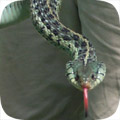 |
|
| The above photo is of a harmless garter snake - yet many people see this snake and assume that it's dangerous. Very few people seem to be able to properly distinguish a venomous snake from a harmless one. As a wildlife removal specialist, I'm
privy to the wildlife opinions of many people. I hear, on a daily basis, just what people think of the wild creatures all around us. It seems that no single type of animal is more misunderstood than snakes. The primary misconception is that snakes are dangerous and must be feared.
In addition, snakes are constantly ...click for more |
09.18.2008 - Red Touch Yellow, Kills a Fellow. Red Touch Black, Friend of Jack
 |
|
| Many people have heard this rhyme for snake identification, even though very few people will ever encounter any of the snake species involved. For some reason, it's simply a popular rhyme, and people
seem to remember the idea that there's some rhymey phrase out there to help distinguish between venomous snakes and safe ones. The snakes in question are the venomous Coral Snake,
and a number of copycats, such as the Scarlet King Snake and the Florida Scarlet Snake. Oftentimes in nature, a species will mimic the appearance of a dangerous spe
...click for more |
07.14.2008 - Eastern Diamondback Rattlesnake
 |
|
| This is an Eastern Diamondback Rattlesnake that I caught. It's a good sized specimen. This snake lives throughout most of the
state of Florida, but it's pretty rare in the Orlando area. It's rare in most developed areas, because it's a slow snake and it stands its ground, and people have a habit of
killing them off. It's true that the bite of this snake is very dangerous - many herpetologists think it's one of the 10 deadliest snakes in the world - but it won't strike
unless provoked. Nevertheless, most people don't like to have them around, so where there's people, there's ...click for more |
04.14.2008 - Types of Florida Water Snakes
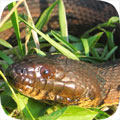 |
|
| Several species of water snake slither and swim their way through Florida's lakes and swamps. The most feared is the venomous
Cottonmouth, or Water Moccasin, as some call it. While these snakes are in fact common in some areas, and while you certainly don't want to be bitten by such a snake, most of
the water snakes in Florida are in fact harmless. The above photo is of a Brown Water Snake that I caught. This snake poses no danger. It's not poisonous, and is usually
docile. Any snake can strike if provoked, but most would much rather just swim away in ...click for more |
02.10.2008 - Can Snakes Climb? Snake Crawls up a Wall
 |
|
| Many people ask me about the climbing capability of snakes. In particular, people want to know if snakes can get up into their attic. The answer is that
yes, some species of snake are excellent climbers, and can climb walls. But not just any wall. The snake must have something to grab ahold of and push off of. Not
even a rough surface will do - snakes can't "stick" to walls the way insects, rats, and lizards often do. The only times I've seen snakes climb walls are brick walls. I've
seen this a few times. The gaps where the brick meets the soffit also provide entry ...click for more |
12.08.2007 - Florida Water Snake
 |
|
| Here is a fine specimen of a Brown Water Snake, (Nerodia taxispilota). This snake is supposedly common in some areas, but I've found only a few during my time as a nuisance wildlife trapper here in Orlando Florida. This snake is, like
pretty much all aquatic snakes, heavy-bodied in comparison to most snakes. Part of the reason for the body shape is because of the buoyancy needed for waterbound critters. I'm surprised that these snakes don't have any sort of a paddle-tail, but they don't. They swim
just fine, moving along the surface of the water via ...click for more |
10.22.2007 - Eastern Coral Snake
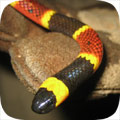 |
|
| This is a close up photo of an Eastern Coral Snake, Micrurus fulvius, that I caught. I'm holding it with thick
gloves. Yes, this snake is a member of the elapid snakes, a family that includes cobras, and it has a very powerful neurotoxin venom that can be fatal to people. However,
this snake is not very aggressive, and as you an see, it has a tiny mouth. It also has small fangs, and it can't inject venom the way the pit vipers do. The venom delivery is
slower. Thus, it's fairly safe to handle with thick gloves and a knowledge of how it can move and what it can do. I of course ...click for more |
08.08.2007 - Pygmy Rattlesnake
 |
|
| Ah, the Pygmy Rattlesnake - one of central Florida's four species of venomous snake. It's supposedly the most common of the four, but I never find them.
I see more Cottonmouths, and I've even caught a few Eastern Diamondbacks and Coral Snakes. This snake is actually the Dusky Pygmy Rattlesnake, Sistrurus miliarius
barbouri. There's a few different species of Pygmies, and they live in the SE United States. I cannot determine if the proper spelling is Pigmy Rattlesnake or Pygmy, but both spellings are used
for the snake. Some people misspell this ...click for more |
06.21.2007 - Baby Cottonmouth Photo / Picture
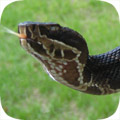 |
|
| This is an important snake to be able to identify in the state of Florida. This is a juvenile cottonmouth snake. As with many snakes, its appearance
is different from that of the adult snake. The young cottonmouth has angular brown and tan bands in a pattern. As the snake ages, these bands fade, and the snake
becomes almost entirely black. The only real identifying coloration marking on the adult is the black band that extends back from the eye. The cottonmouth. or
water moccasin as it's also called, also has an elliptical pupil (see the above eye, how it's cat ...click for more |
05.30.2007 - Eastern Glass Lizard / Snake
 |
|
| This is an Eastern Glass Lizard, (Ophisaurus ventralis), often referred to as a Glass Snake. It is actually a lizard,
but it looks of course, like a snake. It lives mostly in the SE United States, and throughout Florida. They grown up to about 30 inches long, and they eat mostly insects. They
spend much of their time underground, and that's where I caught this one. I was at a customer's house, sealing some holes near the base of the house, and I saw a little bit of
this lizard, and it went under the dirt, and I scrounged it up. I think it is pretty. This reptile got its name from the ...click for more |
04.13.2007 - Red Rat Snake
 |
|
| The Red Rat Snake (Elaphe guttata guttata), is one of the most common snakes that I find and remove in the Orlando
area. Like the Yellow Rat Snake, this snake is a constrictor that feeds primarily on rodents. And Orlando is chock-full of rodents! This snake will lie in wait for a rat to
pass by, or it will sneak up on a sleeping rat, and in a swift motion strike at the animal and wrap the rat up in coils, and suffocate it, then swallow it whole. Not exactly my
method, but nice rodent control nevertheless! I think that the Red Rat Snake is very pretty, with its orange and red pattern ...click for more |
03.05.2007 - America's Deadliest Snake
 |
|
| Behold! The most dangerous snake in America! The rare Hangman's Snake (constrictus dangleus). It sneaks up on you
from behind, latches itself around your neck, and then forces you to choke yourself to death! Sometimes this species gives you a chance to spell out a mystery word, but if you
fail to guess the correct letters and solve the puzzle, it attacks. If you spot this snake, stay calm and turn and walk the other way. It primarily lurks around gallows and
lynching trees, so beware when entering these habitats. Should you find yourself amidst an attack ...click for more |
01.21.2007 - Ringneck Snake Photograph
 |
|
| Here is a photo of me with a nice-sized Ringneck snake. I did not take this photo, as if often the case with photos in which
I appear. No, this photo was taken by the customer, who happens to be a professional photographer. Professionals shoot in black and white you know, which is much cooler than
boring old color. If the photo had been in color, you would have noticed the orange ring around the neck of this snake, its orange belly, and my shimmering olive green/grey
eyes, which evoke memories of the rugged Irish seas on an autumn morn. Alas, in this ...click for more |
12.06.2006 - Florida Brown Snake
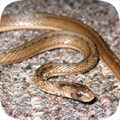 |
|
| The Florida Brown Snake Storeria victais is tiny, and it rarely grows to longer than a foot in length. It ranges throughout most of the Florida peninsula. It's not a very common snake, and because of its small size, boring brown color, and reclusive
nature, it's not commonly seen. It's a member of the common colubrid family of snakes, it's active during the daytime, it mostly eats bugs and little amphibians and reptiles such
as anoles, and it give birth to live young in the summer. It's not venomous. I caught this lovely specimen in one of my snake traps, ...click for more |
10.22.2006 - Florida Scarlet Snake
 |
|
| This is a Florida Scarlet Snake - Cemophora coccinea coccinea. They're not terribly common here in central Florida, at least as far as I've seen. This is probably because they're primarily nocturnal
and spend most of their time under heavy debris and rocks and other cover. This snake is not to be confused with either the Scarlet Kingsnake or the Coral Snake. Regarding the latter, the venomous one, it's important
to realize that the Scarlet Snake is a harmless mimic, and is, in my opinion, very ...click for more |
10.01.2006 - Brown Water Snake
 |
|
| I caught this Brown Water Snake, Nerodia taxispilota, on the shores of Lake Maitland, FL. Many people confuse this snake with the
venomous Cottonmouth, or Water Moccasin. The Brown Water Snake is, of course, an aquatic snake, just like the Cottonmouth. Most aquatic snakes have bulky
bodies. And of course pretty much all snakes have triangular heads larger in size than their necks. Thus, this snake does mimic the body shape of the
cottonmouth, in addition to sharing its habitat. However, the snake is not venomous. It does give birth to live young ...click for more |
09.20.2006 - Florida Ringneck Snake
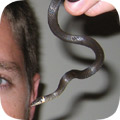 |
|
| The Florida Ringneck Snake is one of the most commonly removed nuisance snakes in the state of Florida. Of course, it's as harmless as an
earthworm. The reason I encounter this snake so often is because it is not only common, but small - and thus it commonly squirms through very small gaps and
into houses. It is the single most commonly encountered snake inside the home here in FL. Snakes explore their habitat, and often squirm through small gaps,
and thus it often finds small holes under doors or other areas, and slithers into a house, and then can't find its ...click for more |
09.11.2006 - Baby Coral Snake
 |
|
| This is a juvenile hatchling Eastern Coral Snake. It's probably a month old at most. Whereas some snakes will constantly slither all over the place, corals will often hold still in one position. I was in a good mood,
so I decided to drape it over my nose. I sent this photo to a friend, who claimed that I must be crazy, as he had heard that the venom of juvenile snakes is more potent than that of adults. I replied that I do not
think this is true. The composition of the venom does not change over the lifetime of the reptile. Although it's true that the neurotoxic venom of the Coral Snake ...click for more |
09.07.2006 - Pine Woods Snake
 |
|
| This is a Pine Woods Snake, (Radinaea flavilata). It is an uncommon snake. It lives throughout most of the Florida peninsula and spotty areas throughout the SE coast, but it's not very common. It's an orange/rust/pinkish colored snake that
spends most of its time under debris, eating bugs and little lizards and stuff like that. It rarely grows to more than 14 inches, and this one was about 10 inches. The only reason I'm even bothering to write about it is because it was a new snake find for me.
It looks similar to the SE Crown Snake or the Florida Brown Snake, both of which ...click for more |
08.24.2006 - Orlando Rattlesnake
 |
|
| Here's an Orlando Rattlesnake - With diamonds on its back - Please, dear reader, make no mistake - It has a most deadly attack
- It's armed with hypodermic fangs - And a nasty disposition - Upon my trusty hook it hangs - In a compromised position - But if you see it on the ground - And if you get too
close - Soon, my friend, you will have found - Yourself with a lethal dose - You may have seen the warning signs - The coiling and the rattle - Because before this serpent
dines - Its tail begins to tattle - Let that serve as ample warning - For you to back away - Wake up ...click for more |
07.26.2006 - Snake Eating Squirrel
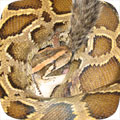 |
|
| I caught this eleven foot Burmese Python yesterday. I was also called to remove a freshly killed squirrel today. I noticed
that the snake was rather thin, with ribs showing and everything, so I figured, "why not?" and I threw the snake the squirrel. I've never kept snakes before as pets, nor do I
know anything about feeding snakes. I left the room and went to do some computer work, and when I came back to check, it was swallowing the squirrel! I took this photo of the
process. The snake had wrapped all around the animal, and was just slowly swallowing it. It was fascinating ...click for more |
07.25.2006 - Burmese Python in Florida
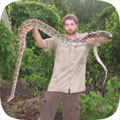 |
|
| This is the largest snake that I've ever caught as a wildlife control operator. At 11 feet in length, it's the longest animal that I've ever caught as well, even longer than that ten foot squirrel I once got. This is a Burmese Python
(molurus bivittatus). It's native to the rainforests of southeast Asia. It's one of the largest species of snake in the world, and the largest known specimen so far is 27
feet long and 400 pounds. I guess that makes the one I just caught seem small, but still, that's one big snake that I caught. I got the call from an apartment complex, and the
snake was actually ...click for more |
05.30.2006 - Eastern Garter Snake - Not Garden Snake
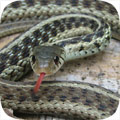 |
|
| The above photo is of an Eastern Garter Snake, (thamnophis sirtalis). This snake is possibly the most commonly sighted
snake in North America. There are many variations of Garter Snake, and the colors and patterns can vary, but for the most part, it's a slender snake with a triangular head,
usually has some form of dark green and tan, and three stripes down the length of the body, on on top and one on each side. This snake is not venomous, and it's the exact same
species that I used to find and pick up and put in a jar and show to my mom for her praise and ...click for more |
05.18.2006 - Pueblan Milk Snake
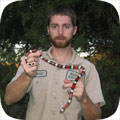 |
|
| I received a call about a Coral Snake in someone's patio. Red, black, and yellow bands, I was told, along with a black nose.
That's a sure description of a Coral, and out I sped to remove the dangerous snake. I showed up to the house, but as is often the case, the snake had left by the time I
arrived. I hate that. I had to drop everything and make a long drive out to the house, and now it had vacated. I scrounged around inside the patio and found nothing, and so
I concluded that it must have slithered out the same way it came in, probably through a gap under the patio ...click for more |
04.29.2006 - Florida Black Racer
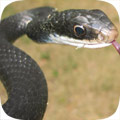 |
|
| Ah, the Southern Black Racer, (Coluber constrictor priapus), the most common snake that I deal with here in Orlando Florida. I estimate that about 40% of all snake calls that I get are due to this one species of snake alone. They are simply
very capable snakes, good at surviging, and they can adapt to a wide variety of habitats. Whereas other snakes inhabit more specific ecological niches, or simply need just the
right protection, Black Racers do fine in a variety of habitats, including suburban and urban. One often has to travel outside of developed Orlando
...click for more |
04.24.2006 - Corn Snake
 |
|
| The Corn Snake, Elaphe guttata guttata, is probably the 2nd most common snake that I find and remove here in Central
Florida. I consider it the prettiest snake that I deal with. It has a beautiful red and orange pattern, and the belly is white with black keyboard markings, from which it
gets its name (apparently the markings look like maize, although I'd have named this snake the piano snake on the basis of its belly). Many people associate brightly colored
animals with poison, and it's true that many critters in nature that choose to stand out via their coloring, which ...click for more |
04.20.2006 - Snake Removal at Carrot Top’s House
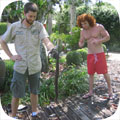 |
|
| This was actually my second time to this customer's house in Winter Park, part of Orlando FL. Both times his assistant and
himself referred to him as Scott, but I recognized him as the prop comedian who goes by the name Carrot Top. I guess he's kind of hard to miss, and the walls of his house are
adorned with various Carrot Top propaganda. My first call to his home came because he had a terrible odor in his house. I knew that it was a dead squirrel. His house was large
with a very complex architecture, and the area of the attic above the room with ...click for more |
03.26.2006 - Snake in the House - How to Get it Out
 |
|
| "EEK!! A SNAKE IN MY HOUSE!!" *faint - This scene plays itself out every day in America. A hapless homeowner turns the corner
into the hall, spots a snake lying about, lets out a high-pitched scream and collapses, and then his wife has to come and resuscitate him, nurse him back to health, and send
him off to counseling to get over this traumatic event. The wife then gets the broom and sweeps the snake out the door, and the problem is solved. I deal with snakes inside
homes almost every week. I've seen several different species. In general, the more ...click for more |
03.01.2006 - Snake Caught on a Glue Trap
 |
|
| What do I do when a customer calls about a snake in a home, but I am unable to find it upon my arrival? I set a glue board trap. This is the only effective trap that I know of for snake removal. I've
heard of funnel-type traps, and I suppose that they might work, but probably not as well as a glue trap. Before you set a glue trap for snakes, here are a few things to know: 1)YOU DON'T NEED TO KILL THE SNAKE. Once the
snake is caught on the glue trap, take it outside, and pour some vegetable oil on the snake - or spray PAM cooking oil, and the snake will wiggle itself free. ...click for more |
01.13.2006 - Poisonous Snakes Of Florida
 |
|
| There are six species of poisonous snake in Florida. Before I continue and describe them, I'll state that the correct term is actually venomous (a specific type of toxin that's actively injected) and not poisonous (any toxin absorbed via touching, eating, or
breathing), but of course I realize that many people aren't familiar with the difference, and are thus searching online for information on poisonous snakes. I'll also point out that poisonous snakes are relatively rare compared to non-poisonous ones. I think there's about 45
species of snake in Florida, and only 6 are pois ...click for more |
11.18.2005 - Snake in the Pool - How To Remove
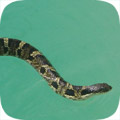 |
|
| I'm commonly called to Florida homes to remove snakes from swimming pools. Many snakes are aquatic, and are drawn to water. It's entirely possible
that they can sense water from a distance, as do many reptiles, perhaps by scent, or perhaps by seeing UV refraction reflecting off the water's surface. Regardless, a
body of water will attract certain critters, and snakes seem to commonly end up in people's pools. Of course, a swimming pool is not a suitable habitat in which to live.
The chlorine makes the water uninhabitable for most life, so there's no forage. I ...click for more |
10.22.2005 - Orlando Florida Coral Snake
 |
|
| Behold! One of central Florida's four venomous species of snakes. This is an Eastern Coral Snake, perhaps 20 inches in length.
This snake doesn't really grow to a very large size, rarely much over 30 inches. I caught this snake in a customer's garage. Snakes often slither their way into garages, and
then get lost amongst the walls and debris. If you leave the snake alone, it will probably find its way out after a while, but I understand, in the case of the Coral Snake,
why one would not want it lurking about under dryer sheets. The venom of the Coral Snake is an ...click for more |
10.09.2005 - Florida Diamondback Rattlesnake
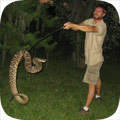 |
|
| This is the most awesome animal that I've ever caught in my career as a wildlife removal specialist. It's a 7 foot Eastern Diamondback Rattlesnake. This species of snake is the deadliest in North America, and this is one of the largest specimens. No documented
cases of an 8-footer have been verified, but that is probably the maximum length. Every now and then a 7-footer turns up, but it's rare that they reach 6 feet. This monster was huge and fat and
in perfect shape, with 12 rattles on its tail. I get many phone calls about rattlesnakes. 99% are false reports. ...click for more |
09.22.2005 - Fastest Snake in America
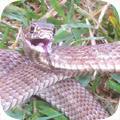 |
|
| This is the fastest snake in the United States of America, the Eastern Coachwhip. It has a top land speed of about 10 m.p.h. and a top air speed of 190 m.p.h. like most aerodynamic objects reaching terminal velocity. Ten miles per
hour may not seem fast, but it is. It's a fast snake! I've seen only two in my life. I caught the above snake, and it took all of my speed and cunning. The second Coachwhip
that I saw was too fast for me to nab, and it escaped under a mobile home. This snake is fairly rare, but another more common snake, the Black Racer, is almost as fast.
...click for more |
08.25.2005 - Snake Hook
 |
|
| Here I am seen holding a snake on a snake hook. The snake hook is a very handy herpetologist's tool. It's used for the safe and easy capture and transportation of snakes. It is most useful when it comes to venomous snakes, which one would not want to
risk handling by hand. The hook can be used in a variety of ways, but the most common is to simply scoop the snake up under its belly and lift it. The snake is draped over the hook, and it then has no leverage with the ground, and no space for peristalsis movement, and so its
pretty much just stuck hanging there. ...click for more |
07.23.2005 - Photograph of Striking Snake
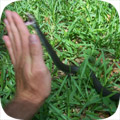 |
|
| Oh no! I'm about to face the paralyzing strike of the deadly Black Mamba! I have only a few precious minutes of life left to
make this web page about the bite and to change into some nice clothes for the morgue! Never mind updating my will, calling loved ones, and reflecting on life - I have a duty
to provide my readers* with the above photograph and account of the incident. Hmm, I seem to still be alive... I suppose that perhaps this wasn't a Black Mamba after all, but
a harmless Black Racer. Yes, now that I look at the picture carefully, I see that this is ...click for more |
06.21.2005 - Yellow Rat Snake
 |
|
| This is a photo of a Yellow Rat Snake, Elaphe obsoleta quadrivittata. This is one of the top eight most common snakes
that I catch in the state of Florida. This snake ranges across the southeast, and the whole state of FL. It's one of the larger snakes in the state, and can reach a length of 6
feet, although it is quite thin. It's got a mustard-yellow body, sometimes dark yellow or tan, with four dark brown stripes along the length of the body. It mates in May, lays
eggs in June, which hatch in August. The baby snakes look nothing like the adults - they are black ...click for more |
05.25.2005 - Extraction of a Snake from an Attic
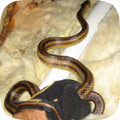 |
|
| Snakes in the attic, snakes in the attic, all I keep hearing about is snakes in the attic. Some people are afraid of snakes, and when they hears noises, or even
nothing at all, they sometimes worry that it's a snake, or a whole mess of 'em, slithering around doing their dirty snake business up in the attic, no doubt plotting a
way down into the home to suck dry the innards of the sleeping innocent within. Most of the time, these paranoid folk are wrong. But not always. Sometimes they are right.
Not about the sucking of innards, but about the snakes in the attic. For you see, ...click for more |
04.09.2005 - Water Moccasin
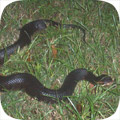 |
|
| This is a photo of a Florida Water Moccasin. It's more commonly called a Cottonmouth, but Water Moccasin is the second most popular name. This snake apparently also goes by black moccasin, blunt-tail moccasin, congo,
cotton-mouthed snake, gapper, highland moccasin, lowland moccasin, mangrove rattler, North American water viper, pilot, rusty moccasin, saltwater rattler, stub-tail, stump moccasin, stump-tail moccasin, swamp lion, trap jaw, Matt Cassan's moccasin, true horn snake,
water pilot, obstucted bowel serpent, water rattlesnake ...click for more |
02.20.2005 - Common Snakes of Orange County, Florida
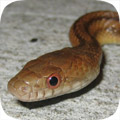 |
|
| I'm frequently asked about the common snakes of Orange County. The above photo is just one of the common snake species in
Central FL. It's a Yellow Rat Snake. I actually found it on the sidewalk in a heavily developed strip mall area here in Orlando. It's one of the snakes that seems to thrive
fairly well in developed areas. Because Orange County is so heavily developed, it's these sort of snakes that are more common. I will now list, in order, the six most common
snakes that I remove and see here in the greater Orlando area, and my estimate regarding the ...click for more |
12.23.2004 - Snake Catcher - How to Catch a Snake
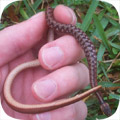 |
|
| Many people ask me how to catch a snake. Before I explain how, I want to stress that oftentimes, it's best to leave snakes alone. Second, it's very important that you are able to identify snakes, and know which ones are dangerous,
and which ones are good and beneficial to have around. Okay then, your four major options for catching a snake are: 1)By hand 2)With snake tongs 3)With snake hook 4)With snake trap. I will analyze these four methods now.
1) By Hand - I've caught the snake in the above photo by hand. I catch most of my snakes by hand. This is because ...click for more |
12.06.2004 - Eastern Coachwhip Snake
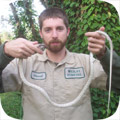 |
|
| Sweet! My first Eastern Coachwhip! I've been reading about this snake, and always wanted to catch, or even see, one. Today I finally got my chance. A customer called about a snake terrorizing his lawn, and now hiding under
a large piece of plywood. I arrived at the house, and upon lifting said plywood, out shot this snake like a lightning bolt! The Coachwhip is the fastest snake in North America!
But it's not faster than me. I pounced with my super duper lightning mongoose speed, and captured the hapless serpent. It struck a few times, but I was impervious to the
...click for more |
10.22.2004 - How to Find a Lost Snake in the House
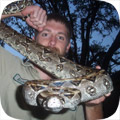 |
|
| I removed the above pictured snake from a residential neighborhood. Whether it was a lost snake or a released pet I can't be sure, but my later experience leads me to believe that it could well have been a lost pet, because
this one was a bonafide escape artist. This snake is a Boa Constrictor. I removed it and brought it back to my house so that I could hang on to it while I waited for a local snake
rescue and breeding group to come pick up the snake. I put the 5 1/2 foot snake in a large cardboard box and closed the top, sealing it shut with a laundry bas ...click for more |
10.06.2004 - Baby Black Racer Snake
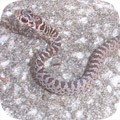 |
|
| Here it is. I probably get more emails about this snake than any other. This snake is incredibly common, especially throughout
Florida, and people see it, don't know what it is, take a photo, email it to me, and ask exactly what crazy new species of snake they've discovered. The answer is that it's a
baby Black Racer. I sometimes answer that it's a juvenile Black Racer or a hatchling Black Racer, but it's a baby Black Racer all the same. Many snakes change color and pattern
as they mature. I'm not sure exactly why, but my guess is that the color pattern on the babies is ...click for more |
09.22.2004 - Florida Cottonmouth Snake
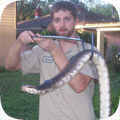 |
|
| Here's a Cottonmouth Snake (Agkistrodon piscivorus) that I caught in Orlando Florida. The Cottonmouth gets its
name from the color of the inside of its mouth, which is white, and which the snake often displays, with a wide open gaping, if threatened. It does not have rattles to warn of
its venomous bite. It is a member of the pit-viper family, which mostly consists of rattlesnakes. The Cottonmouth is a rare exception, and it's also unique because it is an
aquatic snake. It seems to prefer swampy areas the most, but also lives in and around most of ...click for more |
08.12.2004 - Legless Lizard
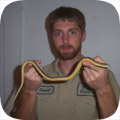 |
|
| This is an Legless Lizard, often referred to as a Glass Snake, although the true name of this reptile is the Eastern Glass
Lizard. What's that you say? I'm wrong you say? You know a snake when you see one, your granddaddy taught you what is and what is not a snake and he'd say that this is a snake,
you say? Well you, and your granddaddy, are wrong. It's a lizard. It just so happens to have the same body design as a snake. This is similar to the way a dolphin may be a
mammal, but looks more like a fish, because having smooth skin, a torpedo shaped body, flip ...click for more |
07.12.2004 - Do Snakes Chase and Eat Other Snakes?
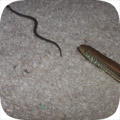 |
|
| I plan to make this my worst snake blog page of them all. There's really no point for it whatsoever, except to showcase the above photo, in which a large snake appears to be chasing a small snake. I say "appears", because first of
all, that's a legless lizard chasing the small ringneck snake, and second of all, it's not chasing at all. I simply put both of these snakes on the carpet at the same time, and they wound up in this configuration. In nature, it's possible that the
legless lizard would in fact eat a small Ringneck Snake like this, but of course, once critters are captured ...click for more |
04.11.2004 - Banded Water Snake
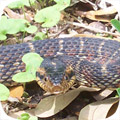 |
|
| This is a Banded Water Snake (Nerodia fasciata). I have photographed it outside of its usual aquatic habitat. I was called to remove a snake from a home, and I was told that I'd be extracting a
Cottonmouth. I arrived at the house and was directed to the ornamental pond in the front landscaping, and sure enough, there sat the above snake, a species that I had
never seen before. It looked a bit darker in the rocks and water, and like most water snakes it had a thick body. I captured it with my snake tongs, and it struck
several times as I transferred it to my snake bag ...click for more |
03.28.2004 - Snake Shedding - About to Shed
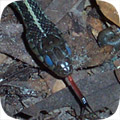 |
|
| I got a call about a snake in someone's flower bed, and the lady said, "It looks like it's from Village of the Damned"! It has
glowing blue eyes!" I arrived on the scene, and found out that she wasn't in fact crazy. This snake DID have glowing blue eyes. In fact, the entire body was fairly blue.
This isn't terribly surprising, seeing as how this snake is a blue-phase Eastern Garter Snake, which is a common species here in Central Florida. Shortly before shedding, the
skin becomes cloudier, and if it's tinted with color, that color is more pronounced. The color shows up a little ...click for more |
03.20.2004 - Orlando Florida Snake Charmer
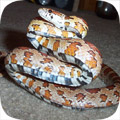 |
|
| Here is a fine photo of one of my favorite snakes, the Corn Snake. This is a fairly small specimen, but it's just as pretty as any of them. It's got
beautiful auburn scales with orange spots, lined in black. The belly has a black and white keyboard pattern, which ye people of olde likened to maize, and that's how this
snake got its name. I sometimes like to play with the snakes I catch, and so I used my expert snake charmer techniques on this snake. I twirl and wiggle my finger in a
certain way, and the snake watches, mesmerized. I bring the finger closer, closer, and ...click for more |
02.20.2004 - Snake Powder Spray to Keep Away Snakes
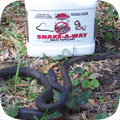 |
|
| "Can't you just put out some sort of a powder or spray to keep away snakes?" I hear this question on a fairly regular basis. I
know that there's a market for such products. Many people simply can't stand snakes, and harbor a real phobia regarding them. And where there's demand, there's products sold to
meet that demand. Alas, so far I have tried every one that I can find, in multiple scenarios, and I am absolutely convinced that none of them work. As a wildlife removal
specialist working in central Florida, I have the opportunity to work with unwanted snakes and in ...click for more |
01.02.2004 - Snake Tongs - Snake Catching Tool
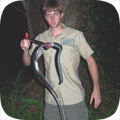 |
|
| I'm seen in the above photo holding a snake that I caught with my trusty snake tongs. This is basically a snake catching and handling tool that consists of a gripping end on a pole, and a lever
handle. The one in the above photo is actually an earlier model of tong, and I've replaced it with the much better Gentle Giant by Midwest Tongs. A good set of snake tongs should be strong and lightweight, and the most important part is the
gripping end. It should be broad, so as to distribute the grip across a wider area and thus hold the snake more gently. Also, it should be ...click for more |
11.08.2003 - Florida Boa Constrictor
 |
|
| Florida is home to many non-native species of plants and animals. People seem to become particularly excited about the presence of non-native snakes. It's true that Florida is host to several species of foreign snake. The subtropical climate
allows for survival of certain species that usually only live in jungles in areas such as central and South America, such as snakes. One such snake is the Boa Constrictor. This is a very well-known snake, and is a member of the python family. It's not nearly as
large as the Reticulated Python or the Anaconda, two of the largest ...click for more |
10.21.2003 - How to spell "Snake"
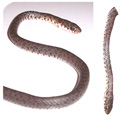 |
|
| I caught this young Black Racer snake today. As you can see, the baby racers look nothing like the sleek black adults. They have maroon patterns and speckles. I had a squirrel in a trap, and just out of curiosity, I put the squirrel and this
little snake together in a bucket. I figured that the little snake would pose no threat to the squirrel. I sure was correct! The squirrel instantly picked up the snake, bit it behind the head, and dropped it dead. It was amazing! I've never seen anything like it!
Had I known that the squirrel would have killed the serpent, I'd have never placed ...click for more |
01.30.2011 - Fractal Snake Images
 |
|
| A nice guy named Ivan wrote to me to tell me that he'd used on of my snake photographs, of a ringneck snake, to incorporate into his fractal images at freymanart.com. Here's what he wrote:
Hi David, I'm a computer graphics programmer and I thought you might want to see some pictures I made with one of your photos. I'm not selling or distributing these pictures... I made them just for fun. For my self-assigned project, I needed
a top-view photo of a snake that had no perspective, a solid untextured background, and lots of contrast. I found this photo ...click for more |
10.04.2003 - Baby Corn Snake Photograph
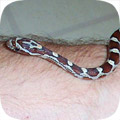 |
|
| This is a photo of a baby Corn Snake. When I first caught it, I was confused by the coloring. It did not match that of the
snakes I usually see. I concluded at first that it was an Eastern Milk Snake. However, with some more research, I discovered that it was a baby Corn Snake. Like many snakes,
the coloration of the juvenile snakes does not match that of the adult - it changes with age. In the case of the Corn Snake, the coloration and pattern changes significantly,
such that the adult is a beautiful golden color with darker orange markings. In addition, this juvenile ...click for more |
09.17.2003 - Snake Emergency Snakebite
 |
|
| "Hello, 911? I've just been bitten by a venomous snake". That's a call I hope I never have to make, and to be honest, I
don't believe I ever will, because I'm armed with the most effective snake protection available - knowledge. While that may sound hokey, it's of course completely true. Since
snakes don't ever attack unprovoked, and since almost all cases of snakebite occur when an ignorant and inexperienced person attempts to handle a dangerous snake, I don't
expect to ever have a problem. However, I will offer advice to anyone who does receive a snakebite. ...click for more |
08.23.2003 - Boa Constrictor caught in Orlando
 |
|
| I caught this Boa Constrictor here in Orlando Florida. An elderly couple called me about a large snake in their garage.
Usually, a large snake turns out to be a tiny three-foot imitation of a pencil. However, these folk weren't kidding! When I showed up, sure enough, there was one large snake
coiled up next to the lawn mower in the garage. I was actually confused about it at first. I wasn't expecting to see a Boa Constrictor out and about, and since I don't have
much experience with pet snakes, I didn't recognize it as a boa at first. I was unable to identify it, and tho ...click for more |
07.11.2003 - Snake Sack - Bag for Snakes
 |
|
| Here I am, catching and removing a snake from a Florida property. There are many ways to catch snakes, from snake hooks, to tong (such as seen above), or by trap or by hand. But no matter how you catch it, you then need to transport it, so that you can
take it away from the property, keep it safe, and then relocate it without harm. The best way to transport snakes is in a snake sack, also called a snake bag. A bag holds the snake comfortably, and keeps it from squirming around. With no flat or hard surfaces, the snake really
can't push off and gain any leverage. A ...click for more |
|
|
|
|
|


